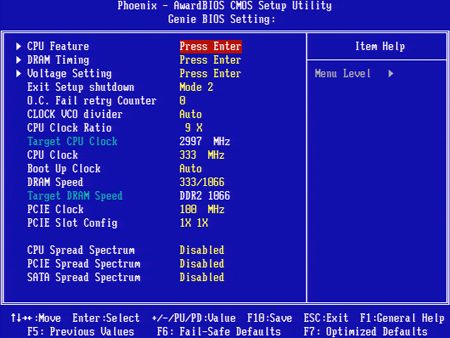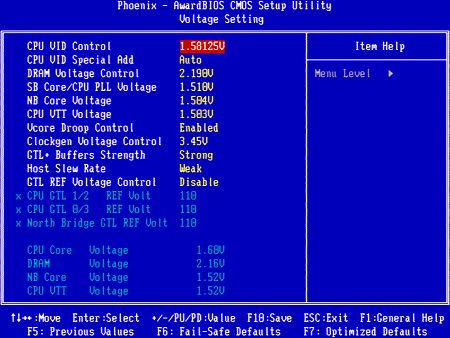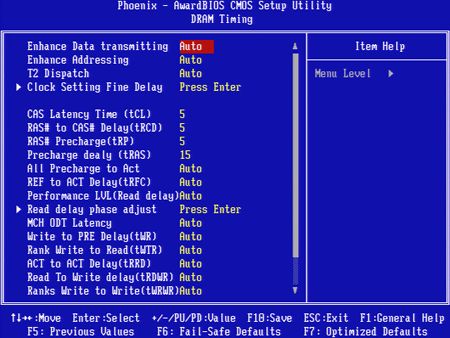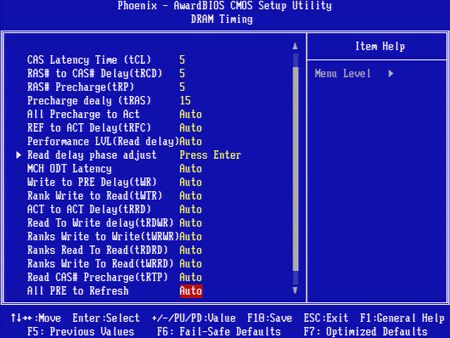X48 Motherboard Comparison, Part 2
BIOS and Overclocking
| FSB Frequency | 200 - 700 MHz (1 MHz) |
| Clock Multiplier Adjustment | Yes |
| DRAM Frequency | All Intel Ratios (by boot strap) |
| PCIe Clock | 100 - 250MHz (1 MHz) |
| CPU Vcore | 0.44375 - 1.6000 Volts (0.00625 Volts) |
| CPU FSB Voltage | 1.211 - 1.601 Volts (0.005 Volts) |
| Northbridge (MCH) | 1.211 - 1.601 Volts (0.005 Volts) |
| Southbridge (ICH) | 1.51 - 2.38 Volts (0.13 Volts) |
| DRAM Voltage | 1.71 - 3.04 Volts (Various Steps) |
| CAS Latency Range | tCAS: 3-9; tRCD: 3-10; tRP: 3-9; tRAS: 1-31 |
DFI provides an excellent range of voltage and timing adjustments in small increments, allowing each overclocker to shoot for the best possible performance his or her components can achieve. The CPU core voltage range does look a little conservative compared to other settings, but DFI also provides a “CPU VID Add” setting to increase the core up to 30% beyond the set voltage, in 0.23% increments.
DFI calls its overclocking menus “Genie BIOS.” The main menu includes basic clock and ratio settings for the CPU and RAM.
The voltage submenu includes VID control, the previously mentioned “VID Add” percentage; DRAM, chipset and per-die GTL reference voltage settings.
The DRAM timings menu has every setting that even the most avid overclocker could want, and those less interested in the more advanced settings will find individual “automatic” options.
Get Tom's Hardware's best news and in-depth reviews, straight to your inbox.
-
nihility I thought the major concern with overclocking was doing it with 4 GB or 8 GB of memory installed and with quad cores.Reply
Buying an overly expensive high end motherboard but installing a 65 nm dual core processor and just 2 GB of RAM seems a very odd combination to me. -
@niReply
Not so odd if you want to get the base foundation set up and then wait for lower prices on higher performance parts later on down the road.
A quad core (3.0 GHz x 4) chip is coming down the pike by years end and DDR3 prices are on the slide. Building an E8400 / 2 GB base machine is exactly what I did to finally migrate from my 5 year old P4 Extreme Edition / Intel 875 based rig.
That's the beauty of the X48 platform; longevity. -
The ECS offering has supposedly been out for around a month, but I can't find it for sale ANYWHERE!! can't even find a price. I used to turn my nose up at ECS products. Our company used Asus boards exclusively thinking they were a higher quality product. Evey one of our Asus boards failed within 4 years. This may be because the Chinese have studied the American business model... Make a product that is designed to either fail or need parts within a calculated period of time. ECS are much cheaper, and so far seem more stable than the Maximus Formula board we purchased recently. The Asus BIOS is for people who like to toy with settings. Unfortunately their BIOS has become complicated beyond their programmers ability too write stable code.Reply
-
Glad to see that gigabyte's board was so much more energy efficient than Asus', or any other board for that matter... especially while overclockingReply
-
Fedor Arcolyte - lol. Did you fall asleep and dream up another page of the review which had power consumption whilst overclocking? :pReply
For the record I'm using my first Gigabyte board (X38-DQ6) and overall I'm pretty happy with it, but having said that I haven't used Asus in at least 5 years. With these comparisons it often comes down to features since performance is pretty near (although the low memory speeds achieved by the Gigabyte surprised me!). -
" Intel covers all of its CPU VRM MOSFET?s with sinks. Our apologies for the alphabet soup that made up the last comment. " -> You could've gone with " Central Processing Unit Voltage Regulator Module Metal?Oxide?Semiconductor Field-Effect Transistor's " , so it's ok =)Reply
-
frodbonzi I wonder how the Asus' Rampage Formula stacks up here? It supports DDR2 or DDR3 and is part of the RoG line... X48 as well...Reply -
xanxaz asrock rocks....lol...although i'll keep my gigabyte... as i dont know where to say this, it's better say it here... your main page is eating my cpu cycles... between 25% up to 50% cpu utilization while viewing your site? please cut down in animated ads... running a c2d at 3.6 and still lags while surfing... dah... it's just your site... os is it me? i think it's the ad on the top right corner that is causing that...Reply -
wozeus I see that Newegg has ECS X48T-A for under $200. Looks like it's a great deal...going to get one.Reply




